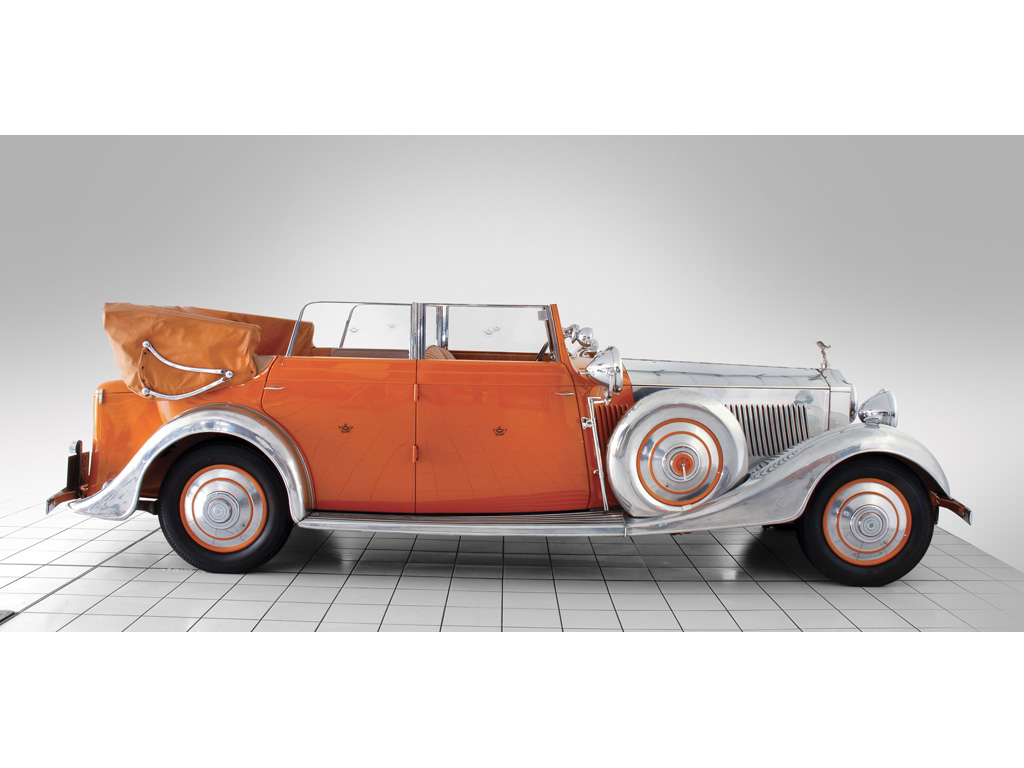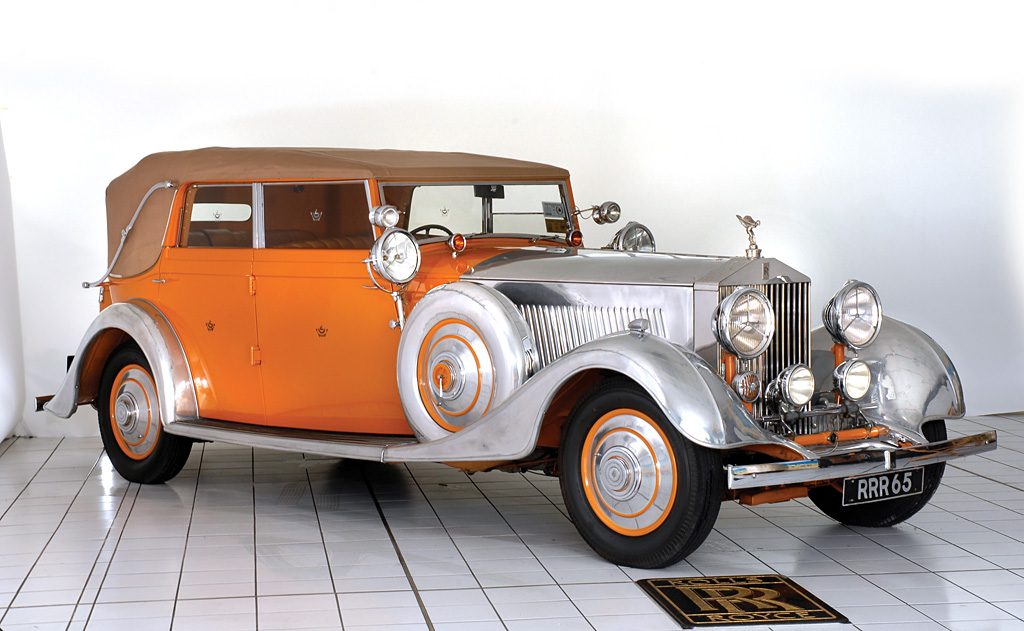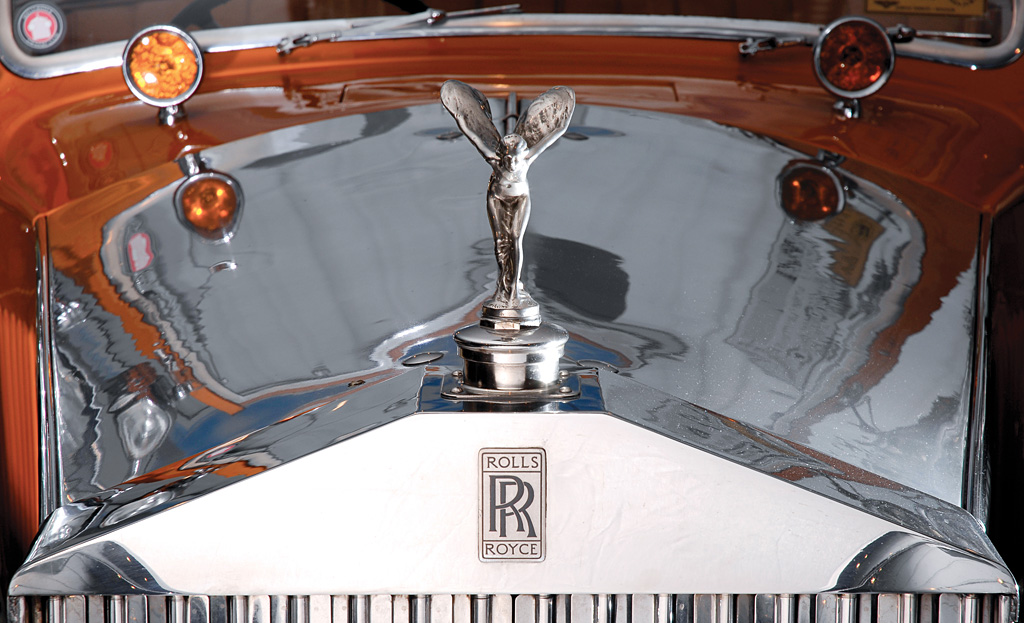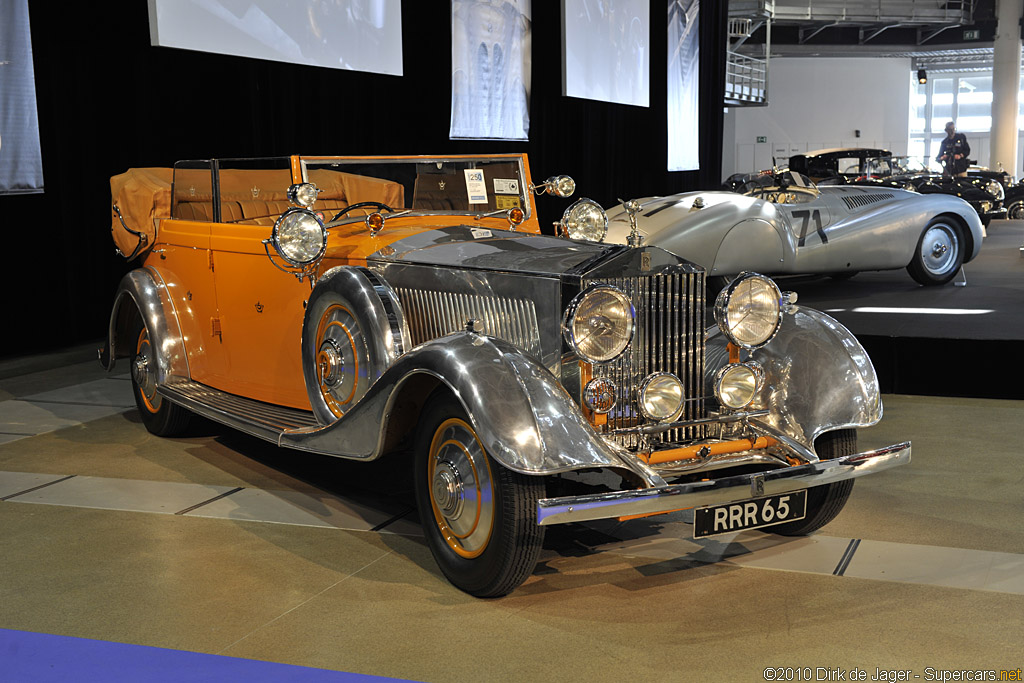1934 Rolls-Royce Phantom II ‘Star of India’
From the early days of motoring, Rolls-Royce cars were favourites of the Maharajahs of India. The rulers of the pre-independence princely states had considerable wealth and were inclined to spend it, on clothes, jewellery, royal palaces and fine motor cars. And so it was in 1934 that His Highness Dharmendrasinhji Lakhajiraj, the Thakore Sahib (Lord) of Rajkot, decided to replace his 20-year-old Rolls-Royce with a new one – not just any Rolls-Royce, but one that has become renowned as the “Star of India,” named for the famous 563-carat star sapphire.
Thakore Sahib Dharmendrasinhji Lakhajiraj, eldest son of Lakhajiraj III Bawajiraj, became ruler upon the death of his father on 2nd February 1930. Early in his reign, he ordered a Rolls-Royce Phantom II to replace the 1909 Barker-bodied Silver Ghost open-drive landaulet (chassis number 60797) that he had inherited from his father. Chassis 188PY was duly completed at the Rolls-Royce works at Derby and dispatched to London coachbuilders Thrupp and Maberly for a handsome and striking All-Weather Cabriolet body.
Thrupp and Maberly, whose roots dated back to 1760, entered the motor body business in 1896 with an electric Victoria for the Queen of Spain. The business expanded rapidly, and the firm regularly exhibited at British motor shows from 1910 onward. After World War I they produced landaulets, limousines, coupés-de-ville and cabriolets, frequently on imported chassis like Delage, Hotchkiss and Minerva.
In 1926, Thrupp and Maberly were acquired by the Rootes brothers and gave the whole Rootes organization a flagship enterprise that catered to wealthy clients and their Rolls-Royce, Daimler and Bentley cars. Moreover, during this period a number of significant innovations emanated from Thrupp and Maberly: the tilting glass division window, which provided greater rear legroom, and hinged rear quarter lights for better ventilation.
His Highness’s new car was painted saffron ochre, a shade which symbolised purity, while the bonnet and wings were left in polished aluminium. The interior was trimmed in ochre leather, and the wood dashboard was marbled with saffron paste. It had steerable driving lights and two small lights that flashed orange, signalling that the road should be cleared for its royal passenger. There were searchlights on each side, with smaller lights attached to the windshield, each with a mirror on its back side. The Rajkot state crest appeared on the doors and side windows along with the motto “Dharmi praja raja,” meaning “An impartial ruler of men of all faiths.” The back of the front seats has a lovely half moon and full moon design made of ivory and dark semi-precious stones, with two small ivory elephant heads in the middle.
The reign of Thakore Shri Dharmendrasinhji Lakhajiraj, however, was not a happy one. His lavish lifestyle and heavy taxation of his subjects vexed the citizens, who did not appreciate his collection of fine cars. There were many protests, strikes and demonstrations. Finally, Thakore Sahib Dharmendrasinhji died early in 1940, while hunting lions in the Sasan Gir forest.
Little is known of the Star of India from this period until the 1960s. The name is thought to have been bestowed in modern times, but it has become indelibly linked to the car, which was apparently driven sparingly as the odometer today has recorded barely 30,000 kilometres. In 1965, British collector Bill Meredith-Owens found the car while adventuring in Rajkot. He immediately wanted it, but negotiations for its acquisition and export took three years. Once expatriated, it became the star attraction at his museum at Stratford-upon-Avon, Warwickshire and was issued the distinctive British registration RRR65.
Meredith-Owens had Wood and Pickett carry out a general overhaul in 1970, after which he and his wife took the car on a lengthy tour through Sweden and Norway. In 1977, it was a participant in the great Rolls-Royce parade at Windsor Castle to celebrate the Silver Jubilee of Queen Elizabeth II.
In 1989, after Bill Meredith-Owens’ death, his heirs sold the car collection. After purchase by a German doctor, the Star of India came to the notice of Rolls-Royce collector Hans-Günter Zach, who purchased it in 2000.
In 2001, the Star of India suffered an engine fire that affected parts of the front body area and interior. Expert repairs were carried out, making the car ready for Techno Classica in Essen in April 2002 and a return trip to England later that month for Queen Elizabeth’s Golden Jubilee, where British Rolls-Royce author Bernard King rode in the car. The work conducted to the interior and the extraordinary leather cost over €70,000. It was named “most beautiful vehicle” at the 2002 European Concours d’Elegance at Schwetzingen, Germany and received a similar award at Tulln, Austria in June 2004.
During Zach’s ownership, it has chauffeured such notables as Roland Koch, acting minister-president of Hesse, Germany, and opera stars Günter Wewel and Johannes Kalpers. In 2003, it was part of a special broadcast of ARD, the German public television service. At the event, Mr. Zach drove Johannes Heesters, the oldest working actor in the world, on stage to celebrate his 100th birthday. In all, 188PY has made 24 television appearances in Germany alone, 200 press and magazine reports and showings at countless classic car events, including five Techno Classicas and numerous concours events, including Villa d’Este. As such, it comes with two enormous files of reports, clippings and the like, documenting its fame.
Aside from AX201, the original Rolls-Royce Silver Ghost (which was on display in Mr. Zach’s museum for two weeks in 2002), perhaps no car is as renowned and admired as the Star of India. The pattern for several highly-detailed model cars, it has been kept in perfect condition since its 2001 restoration and has excellent paint and new leather. The wood has all been refinished, and the body fittings are in very good condition. It runs and drives well. With its princely provenance, it is one of the most desirable cars in the world.
In Detail
| submitted by | Richard Owen |
| type | Series Production Car |
| production | 1 |
| engine | Inline-6 |
| position | Front Longitudinal |
| aspiration | Natural |
| valvetrain | OHV |
| displacement | 7668 cc / 467.9 in³ |
| bore | 107.95 mm / 4.25 in |
| stroke | 139.7 mm / 5.5 in |
| compression | 4.75:1 |
| body / frame | Steel over Steel Chassis |
| driven wheels | RWD |
| front brakes | Drums w/Servo Assist |
| rear brakes | Drums w/Servo Assist |
| steering | Worm & Nut |
| f suspension | Rigid Axle w/Semi-Elliptic Springs |
| r suspension | Live Axle w/Semi-Elliptic Springs |
| wheelbase | 3658 mm / 144.0 in |
| front track | 1486 mm / 58.5 in |
| rear track | 1486 mm / 58.5 in |
| transmission | 4-Speed Manual |
Auction Sales History
1934 Rolls-Royce Phantom II ‘Star of India’ – sold for €644,000
From the early days of motoring, Rolls-Royce cars were favourites of the Maharajahs of India. The rulers of the pre-independence princely states had considerable wealth and were inclined to spend it, on clothes, jewellery, royal palaces and fine motor cars. And so it was in 1934 that His Highness Dharmendrasinhji Lakhajiraj, the Thakore Sahib (Lord) of Rajkot, decided to replace his 20-year-old Rolls-Royce with a new one – not just any Rolls-Royce, but one that has become renowned as the “Star of India,” named for the famous 563-carat star sapphire.
Thakore Sahib Dharmendrasinhji Lakhajiraj, eldest son of Lakhajiraj III Bawajiraj, became ruler upon the death of his father on 2nd February 1930. Early in his reign, he ordered a Rolls-Royce Phantom II to replace the 1909 Barker-bodied Silver Ghost open-drive landaulet (chassis number 60797) that he had inherited from his father. Chassis 188PY was duly completed at the Rolls-Royce works at Derby and dispatched to London coachbuilders Thrupp and Maberly for a handsome and striking All-Weather Cabriolet body.His Highness’s new car was painted saffron ochre, a shade which symbolised purity, while the bonnet and wings were left in polished aluminium. The interior was trimmed in ochre leather, and the wood dashboard was marbled with saffron paste. It had steerable driving lights and two small lights that flashed orange, signalling that the road should be cleared for its royal passenger. There were searchlights on each side, with smaller lights attached to the windshield, each with a mirror on its back side. The Rajkot state crest appeared on the doors and side windows along with the motto “Dharmi praja raja,” meaning “An impartial ruler of men of all faiths.” The back of the front seats has a lovely half moon and full moon design made of ivory and dark semi-precious stones, with two small ivory elephant heads in the middle.
The reign of Thakore Shri Dharmendrasinhji Lakhajiraj, however, was not a happy one. His lavish lifestyle and heavy taxation of his subjects vexed the citizens, who did not appreciate his collection of fine cars. There were many protests, strikes and demonstrations. Finally, Thakore Sahib Dharmendrasinhji died early in 1940, while hunting lions in the Sasan Gir forest.
Little is known of the Star of India from this period until the 1960s. The name is thought to have been bestowed in modern times, but it has become indelibly linked to the car, which was apparently driven sparingly as the odometer today has recorded barely 30,000 kilometres. In 1965, British collector Bill Meredith-Owens found the car while adventuring in Rajkot. He immediately wanted it, but negotiations for its acquisition and export took three years. Once expatriated, it became the star attraction at his museum at Stratford-upon-Avon, Warwickshire and was issued the distinctive British registration RRR65.
Meredith-Owens had Wood and Pickett carry out a general overhaul in 1970, after which he and his wife took the car on a lengthy tour through Sweden and Norway. In 1977, it was a participant in the great Rolls-Royce parade at Windsor Castle to celebrate the Silver Jubilee of Queen Elizabeth II.
In 1989, after Bill Meredith-Owens’ death, his heirs sold the car collection. After purchase by a German doctor, the Star of India came to the notice of Rolls-Royce collector Hans-Günter Zach, who purchased it in 2000.
In 2001, the Star of India suffered an engine fire that affected parts of the front body area and interior. Expert repairs were carried out, making the car ready for Techno Classica in Essen in April 2002 and a return trip to England later that month for Queen Elizabeth’s Golden Jubilee, where British Rolls-Royce author Bernard King rode in the car. The work conducted to the interior and the extraordinary leather cost over €70,000. It was named “most beautiful vehicle” at the 2002 European Concours d’Elegance at Schwetzingen, Germany and received a similar award at Tulln, Austria in June 2004.
During Zach’s ownership, it has chauffeured such notables as Roland Koch, acting minister-president of Hesse, Germany, and opera stars Günter Wewel and Johannes Kalpers. In 2003, it was part of a special broadcast of ARD, the German public television service. At the event, Mr. Zach drove Johannes Heesters, the oldest working actor in the world, on stage to celebrate his 100th birthday. In all, 188PY has made 24 television appearances in Germany alone, 200 press and magazine reports and showings at countless classic car events, including five Techno Classicas and numerous concours events, including Villa d’Este. As such, it comes with two enormous files of reports, clippings and the like, documenting its fame.
Auction Source: 2010 RM Auctions Sporting Classics of Monaco

















